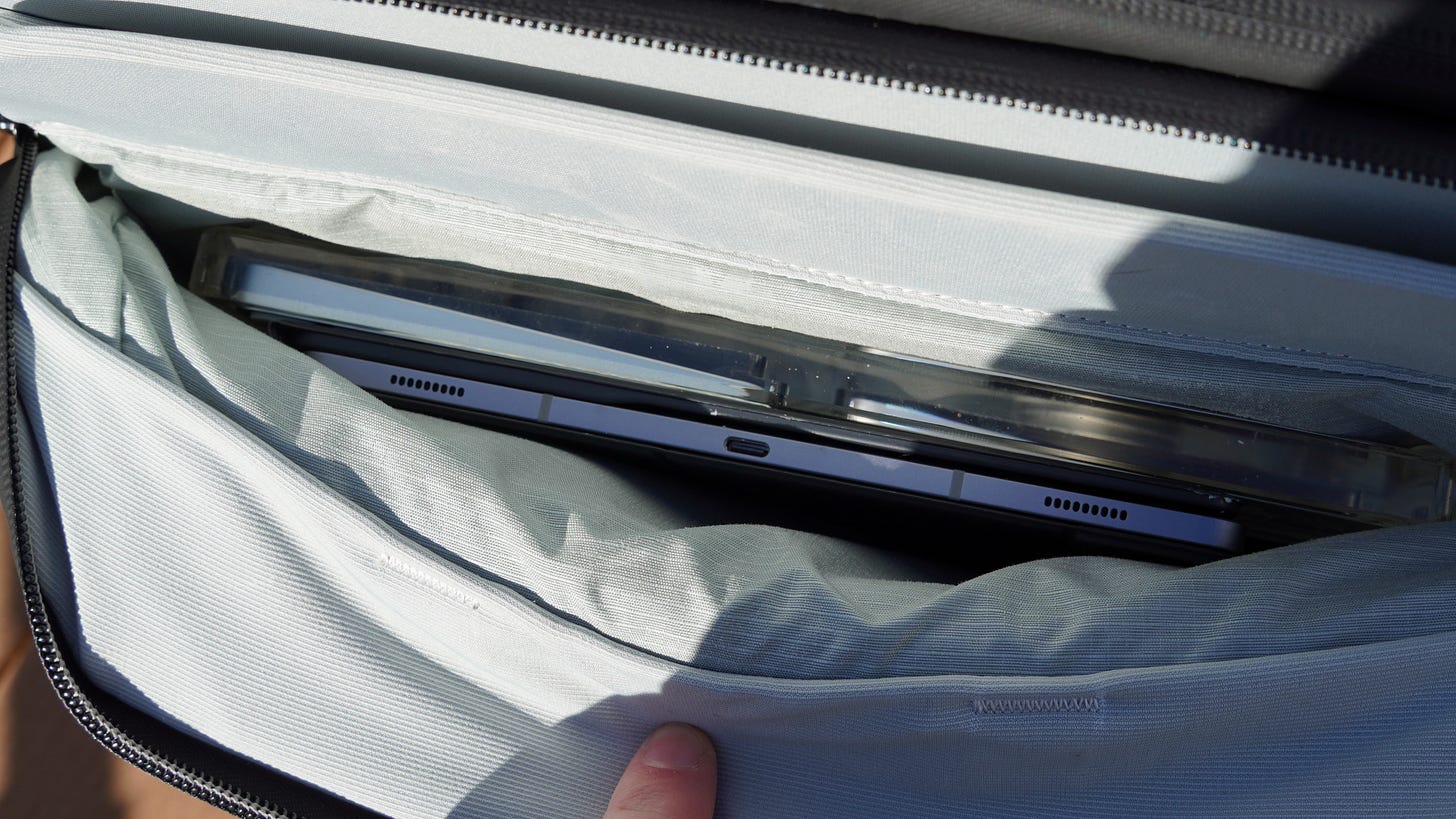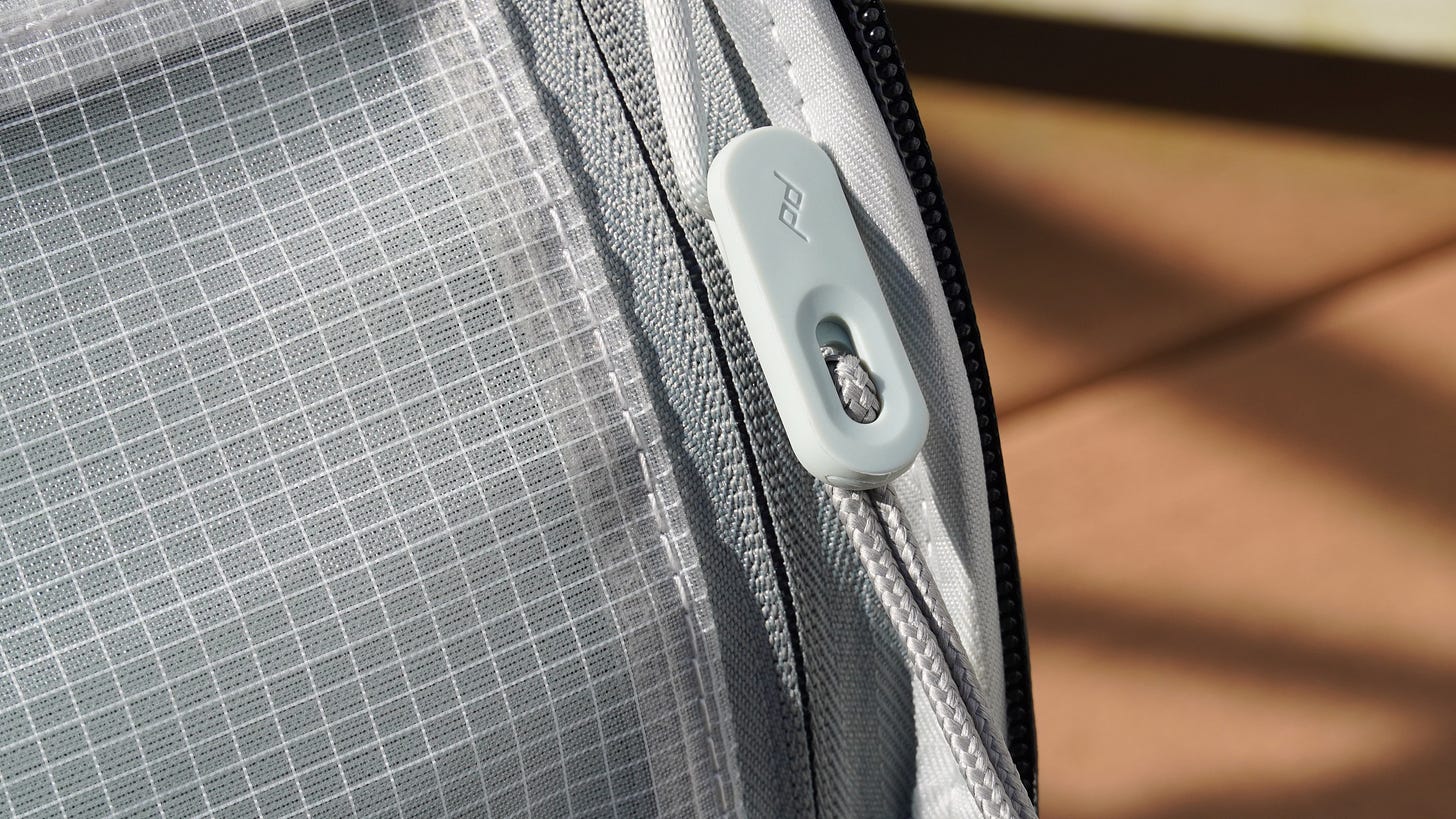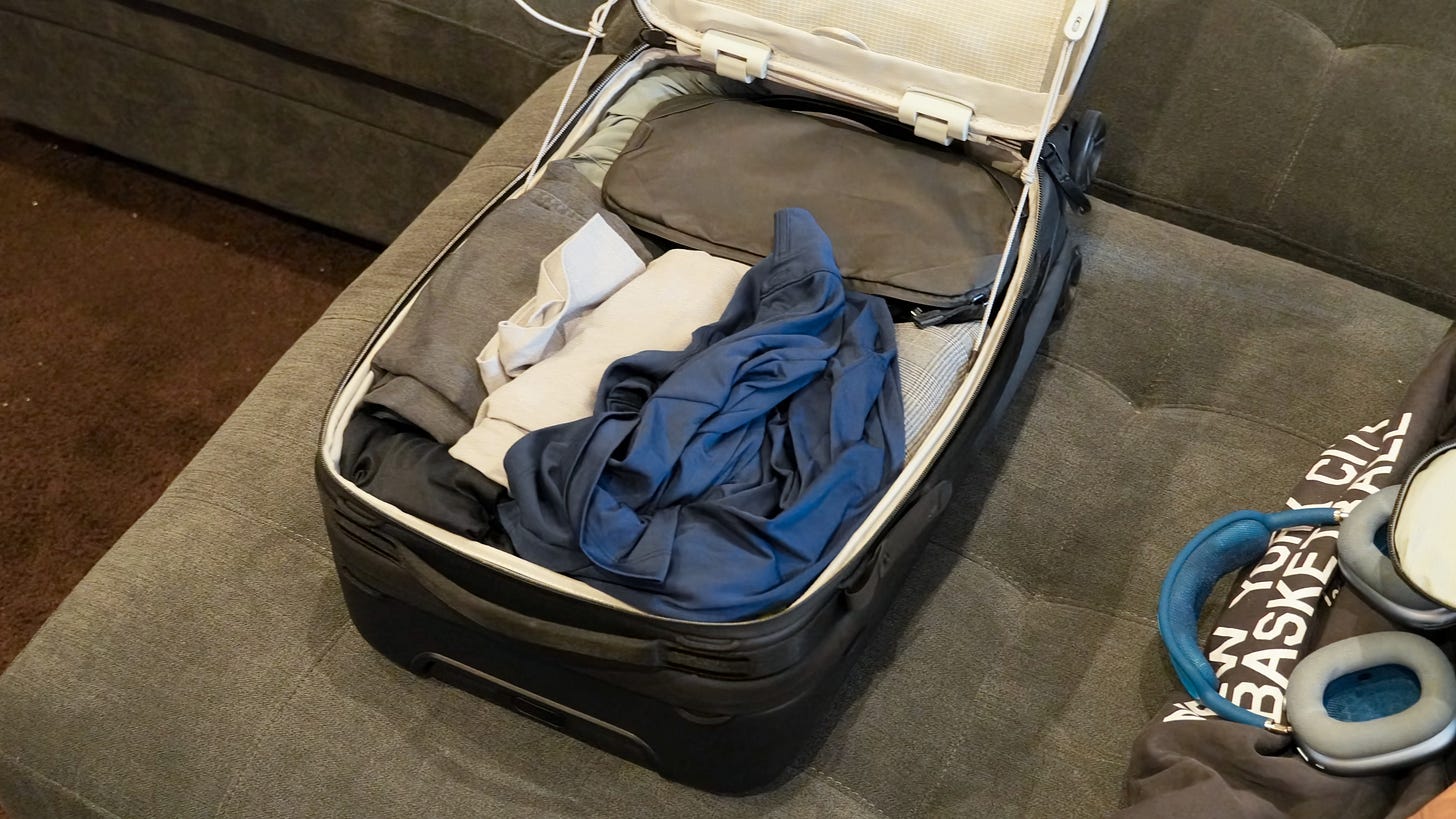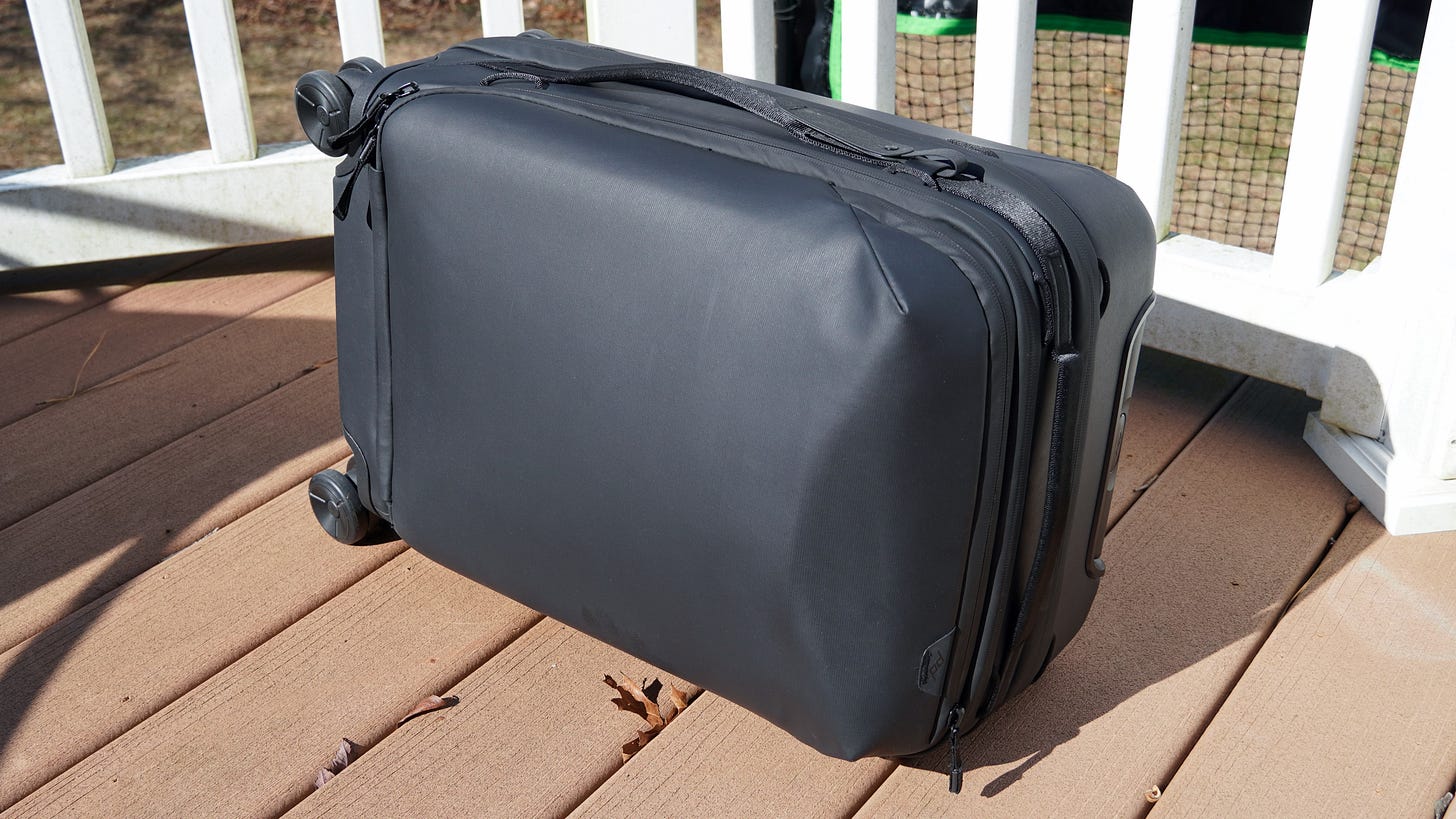Peak Design Roller Pro hands-on: 5 things I love (and 3 things I don't)
Solving many of my gripes with premium carry-ons while providing Peak's famous lifetime warranty, the Roller Pro is as close to a slam dunk as you'll find.
I’m not shy about paying for expensive gear, and that’s why I shelled out a whopping $440 for a carry-on suitcase a few years ago. I bought the Samsara Grand Carry-on for my partner and I, and things haven’t gone so well. On our very first trip, an airline forced us to check one of the Samsara suitcases, and its hard shell cracked. The other suitcase held up a bit longer, but flash forward a few years and its plastic latches are starting to fall apart.
That’s why when Peak Design offered to send me a Roller Pro, the brand’s first attempt at a suitcase, I jumped at the opportunity to test it out. In the past, I’ve reviewed Peak Design’s Outdoor Line, Everyday Line, and Travel Line, and rotate gear from those lineups regularly. For reference, I daily a Sony a6400 mirrorless camera with Peak’s micro clutch attached, and my current EDC bag is the Topo Designs Apex Global Briefcase.
After many teasers, the Roller Pro is launching today on Kickstarter. It’ll retail for $599.99 when it becomes available through Peak Design and partners in June 2025. If you back now, it’ll be available either at a bigger discount if you want to wait beyond widespread availability, or a smaller discount if you want it ASAP. With that being said, I’ve been using the Peak Design Roller Pro for about a month, so let’s review what I like (and what I don’t) about this suitcase.
FYI - Peak Design provided a sample of the Roller Pro for the purposes of this article, but didn’t have any input and didn’t see it before publishing. I don’t use affiliate links, so I won’t earn anything if you decide to back this Kickstarter.
What I like about the Peak Design Roller Pro
First off, let’s review a few quick facts about the Peak Design Roller Pro. It might look like a backpack, but it’s not. This a carry-on-sized bag that uses a hybrid build that includes a polycarbonate inner shell with VersaShell fabric covering it. Instead of opening like a clamshell, Roller Pro uses what Peak Design calls a “drawbridge” opening system. It unzips from the front, folding outward and secured with cord hooks. You can detach the cord hooks if you’d like to allow the carry-on to open up completely.
Roller Pro isn’t an ultralight carry-on by any means, as those typically weigh between 4-6 pounds. The suitcase measures 21.8 x 14 x 9 in. and weighs 8.8 pounds. The company says it’s approved for international carry-on sizes, but that likely only applies when the bag isn’t expanded. Roller Pro starts at a 34L size but can be expanded to 39L. When I checked United’s size restrictions ahead of my cross-country flight, I learned that the expanded size would certainly be too big. As always, your mileage may vary.
Easy access to a laptop/tablet sleeves and travel essentials
A stick of deodorant, allergy medicine, and TUMS were never far away
While I would consider myself an amateur photographer, I’m a tech guy first and foremost, so I review gear through that lens. That’s why I like that Peak Design thought to include a laptop or tablet sleeve on Roller Pro. The top-front of the bag includes a small pocket with room for a laptop, tablet, or magazines — or a combination of those types of items. The top of the pocket has a pouch similar to those you’d find on a Peak Design backpack, and there’s a divider for keeping things organized.
It’s hard to understate how essential this pocket is. I keep a stick of deodorant, a bottle of Zyrtec allergy medicine, some TUMS, or really whatever else I need quick access to inside it. If I was traveling on a long-haul route, I might keep a toothbrush or other toiletries there. My last suitcase was a hard-shell, and this kind of thing wasn’t possible.
Then, there’s the laptop compartment. It’s deep, with enough padding and rigidity for me to feel confident putting valuables in there. As someone who carries with multiple tablets and laptops for every trip, this is a must-have feature. It also makes one-bag travel possible with just Roller Pro.
The SlimDrive handle and ‘drawbridge’ opening system really work
I can pack this roller full of gear and stuff without laying on it to shut it
Peak Design touts two things about Roller Pro that make it different from the competition: the SlimDrive handle and the “drawbridge” opening system. The company explains in a press release that the SlimDrive is “a patented, low-profile carbon fiber handle, engineered for maximal strength in a minimal volume.” Essentially, it’s supposed to give you more interior space without sacrificing durability.
I’d say the SlimDrive is as good as advertised, at least in this regard. There are some potential drawbacks I’ve discovered that we’ll review later. For now, Peak Design’s claims that the SlimDrive takes up a third of the space of a traditional telescopic handle seems accurate. I was able to cram more into the Roller Pro than my last carry-on, despite the Samsara Grand Carry-on I was replacing’s claimed 43.5 liter internal capacity. Plus — I didn’t have to jump on top of the Roller Pro to zip it up.
Here’s a quick list of all I fit inside the Roller Pro:
Front pocket: Deodorant stick, Zyrtec, medicine ziplock bag
Laptop sleeve: Tablet, keyboard, trackpad
Organization panel: AirTag
Packing gear: Small camera cube, ultralight packing cube with Nike running shoes inside
Clothes: 4 pairs of pants, 2 thick hoodies, 5 t-shirts, 1 pair of running shorts, 2 athletic shirts, 1 polo shirt, small ultralight packing cube stuffed with underwear and socks
I like the drawbridge system because it makes it easier to open and maneuver Roller Pro in tight spaces. It’s easy to make it your own with the cord hooks. As I learned with my time testing the Outdoor Backpack 25L, the cord hooks can be somewhat daunting if you’re a first-timer, but after that you get the hang of things quick.
It has just the right amount of interior pockets
You can use them, but won’t lose space if you don’t
I enjoy organization as much as the next guy, but pockets are usually bad. They take up space and if you don’t have something that perfectly fits inside them, pockets are more of a nuisance than anything else. The good news is that Roller Pro’s pockets are nearly flat and don’t take up much space. The main compartment is free of pockets — they’re all on the “interior organization panel,” a.k.a. the front part of the suitcase that opens up like a drawbridge.
You get three wide pockets that are all the same size. They’re not advertised as being water-resistant, but they appear to be ideal for toiletry organization, or wet clothes. Those three smaller pockets are part of one big pocket, which can be stuffed with whatever you want — dirty clothes seem like a safe bet. There’s no “good” place for a garment bag in Roller Pro, but this larger pocket is your best option.
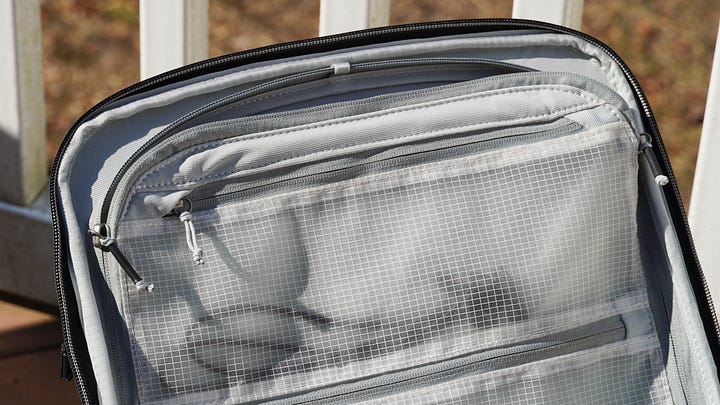
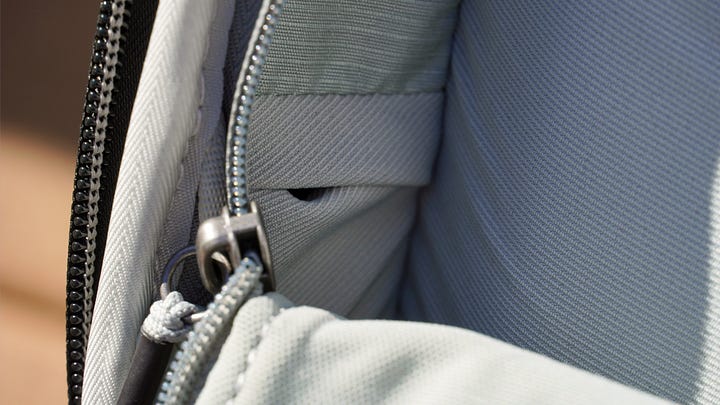


Inside that big pocket is a hidden AirTag pocket that’s thankfully actually hard to access, and a Passport pocket you probably won’t ever use. It could come in handy if you’re flying domestic and want a backup for your driver’s license or government ID that’s stored in a separate place.
But as I mentioned, the best feature about Roller Pro’s pockets are that there aren’t any in the main compartment. Peak Design could’ve packed the main compartment full of pockets, but instead relies on the cord hook and packing/camera cube systems for organization.
Speaking of things Peak Design could’ve included on the Roller Pro, but didn’t: TSA locks. The way Peak explained this omission to the press is simple. TSA locks are a controversial feature — some people like them, others don’t. The company didn’t want to put something on Roller Pro that only half of people use, so TSA locks aren’t standard on the carry-on bag. You can still get a third-party lock and use it to secure both ends of each zipper together to keep the bag closed.
This was absolutely the right choice, because TSA locks are pointless. They can be unlocked with a master set of keys that any would-be thief can easily buy online. Or, if I really want to steal your stuff without buying a master set, I can just cut the lock or the bag itself. I, for one, am glad there isn’t a bulky TSA lock built into the Peak Design Roller Pro.
The modular Camera and Packing Cube storage is ingenious
You can create any ratio of tech and clothes storage, and it’s TSA-proof
The wide-open main compartment, which relies on the packing and camera cubes, isn’t perfect. We’ll get to that later. But it’s pretty damn good, and lets users configure whatever ratio of tech/camera gear they’d like. Peak Design is debuting the XL Camera Cube alongside Roller Pro, which perfectly fits inside the suitcase, filling all of the interior space. Speaking with professional photographers and videographers over the years, there will certainly be an audience for a feature like this.
I don’t own or need that much camera gear, so the XL Camera Cube isn’t really for me. Instead, I went for a Small Camera Cube and two Ultralight Packing Cubes. The rest of the space got filled up by clothes. It worked out great, because I was able to fit more tech and gadgets inside my carry-on than usual. I crammed an M4 Mac mini (yes, I travel with one now), about 7 smartphones (sorry, the Nothing Phone 3a series just launched), and a Fiio cassette player with a bunch of tapes (no excuse for this one, other than I love music) inside the Small Camera Cube.
Something the company mentioned that really resonated with me as a consumer is that the camera cube system makes it easy to take out all your tech or camera gear at once, if you need to. This could be during a TSA check or if you are required to gate check your carry-on. It’s not an exaggeration to say that I’m terrified of either of those outcomes when I mix in tech or camera items with my clothes. The combination of a few Roller Pro aspects — drawbridge opening system for tight spaces, easy-access laptop pocket, camera cube support — have all but eliminated my worries.
No, you don’t need Roller Pro. But if you’re like me and carry thousands of dollars worth of gear (pls don’t rob me) for just a weekend trip, Roller Pro might give you enough piece of mind to make you want it.
If you break it, Peak will (probably) fix it
Roller Pro is backed by the same lifetime warranty Peak Design regularly honors
Perhaps the best Roller Pro feature is that it’s backed by Peak Design’s lifetime warranty. If you ask me, this makes any controversy about the pricing irrelevant. $600 for a bag that’ll last my whole life? Sign me up. Considering I’ve lost a suitcase or two to damage while traveling and I’m only 22 years old, this is music to my ears.
Some aspects of Roller Pro are designed to be easily replaceable, like the 60mm wheels. Others aren’t, like the SlimDrive handle. Either way, if your bag breaks, Peak Design will probably fix it.
I only say probably because warranties are only ever as good as a company a) continues to exist and b) wants to honor them, so they’re not a certainty. However, I see examples of Peak Design customers getting taken care of with warranty claims all the time on social media, and I’m confident recommending the company’s warranty as a key selling point.
What I don’t like about the Peak Design Roller Pro
I took the Peak Design Roller Pro on a cross country trip from Phoenix to Newark that involved multiple car rides, airtrain journeys, commuter rail trips, and five hours in the air — plus everything in between. I’m pretty rough with my gear, and try to get from point A to point B by traveling as quick as possible (must be the cross country runner in me). So, if there’s a weak point in Roller Pro, I’ll probably find it.
There’s too much ‘roll’ in the Roller Pro
It starts rolling away every time I let go of it
One of the great things about Roller Pro is both the wheels and the SlimDrive handle have a satisfying glide to them. However, the wheels have a bit too much glide. I can’t get the Roller Pro to stay still on a hard surface, no matter how flat it is. Basically any time I let go of the bag at the airport, whether it was to unload my pockets at TSA or to order a Jersey Mike’s sub, it rolled away. Although this was a really annoying part of using the bag, it’s not quite enough to get me to stop using it.
Camera Cubes could fit better in the main compartment
Securing them like you would in a Travel or Outdoor bag will waste space
Peak Design bags that use camera cubes and packing cubes for organization usually utilize clips or cord hooks to secure things inside the bag. Naturally, I tried to configure the Peak Design Roller Pro the same way, using the clips that came inside the camera cubes. I hooked the clips onto my camera cube, and then to the loops inside the Roller Pro.
While the cubes stayed secure inside Roller Pro, I noticed that not every cube is going to be the same shape as the interior of the main compartment — leading to wasted space. As a result, I opted to leave my cubes unsecured in the Roller Pro as to not waste any space, shoving clothes in the nooks and crannies. It would’ve been nice to see a better system for securing the non-XL cubes.
I’m not sure the SlimDrive handle will hold up over time
It already scratched after one trip in the air
Things rarely break within my relatively short testing period, but usually there’s a part or two that I start to worry about. With the Peak Design Roller Pro, it’s the SlimDrive. The thinness of the handle is slightly concerning, because I quickly learned that I have a tendency to beat up the handles on my suitcases. While riding on the subway or train, I’ll usually lean against my suitcase and handle, pushing it against a seat, pole, or wall for stability. This is something I’ve never noticed, because other suitcases didn’t make me think about it. However, the amount of flex I noticed in the SlimDrive handle when leaning up against it has me a tiny bit spooked about its longevity.
I also picked up on some scratching on the carbon fiber surface of the SlimDrive handle. I can’t say for sure how this happened, but my theory is that it could’ve occurred when raising or collapsing the handle off-angle. Either way, it is visibly scuffed. It’s worth noting that this is a pre-production sample, and it’s possible some of these kinks are worked out before Roller Pro enters mass productions.
Really, I couldn't care less about the appearance of the carbon fiber finish — this bag is a tool and my main priority is that it doesn’t break. I do have concerns about the SlimDrive handle, but if things do go wrong, you do have that lifetime warranty.
Would I buy the Peak Design Roller Pro?
There were certainly pros and cons to using the Peak Design Roller Pro as my carry-on suitcase, but the short answer is that I’d pay full MSRP for this thing. The tech-focused design and lifetime warranty were enough to sell me, and I’m even going to recommend Roller Pro to some of my non-tech friends and family. I’ve tried many suitcases, some nearly as expensive as this one, and too many that claim to be “smart” or “tech” luggage and drop the ball.
This bag won’t be for everyone, but it does deliver on nearly all the promises it makes.





